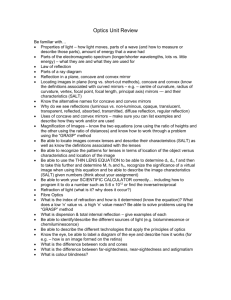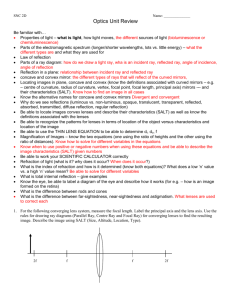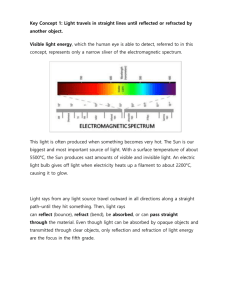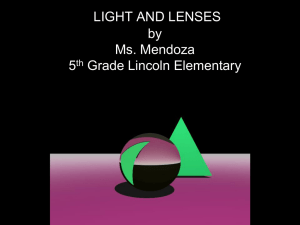Chapter 5 - Unit 2
advertisement
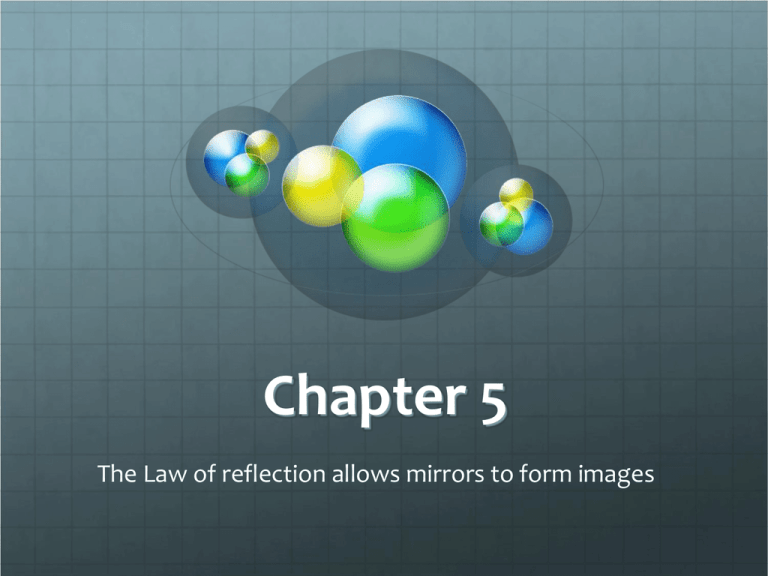
Chapter 5 The Law of reflection allows mirrors to form images Section 5. 1 – The Ray Model of Light The ray model of light can be used to understand how light moves in straight lines, reflects off mirrors and refracts through lenses. In order for you to see an object, it must reflect some light back to your eyes. Sir Isaac Newton believed that light is a stream of fast-moving, unimaginably tiny particles. A ray is an imaginary line showing the direction in which light is traveling Transparent Materials – allows light to pass freely through it. Only a small amount of light is absorbed and reflected. Translucent Materials – most light rays get through, but are scattered in all directions. They do not allow objects to be seen distinctly. Opaque Materials – prevents any light from passing through it. It only absorbs and reflects light. Rectilinear Propagation – light travels in a straight line. The distance from a light source affects the size of the shadow that an object makes. The closer an object is to a light source, the smaller the shadow. Page 175, Questions 1 -4 Reflection – 2 different types 1. Specular Reflection – reflection from a mirror-like surface, which produces an image of the surroundings. Specular Reflection 2. Diffuce Reflection – reflection from a rough surface, which does not produce a clear image but instead allows you to see what is on the surface. An example of Diffuce Reflection Diffuse reflection allows you to read print on a page. The black ink, on a white page, will absorb most of the light. The white page will reflect rays which go out in all directions. Page 177, Questions 1 - 3 Law of Reflection The angle of reflection of a light ray is equal to the angle of incidence, or the angle at which the ray strikes the reflecting surface. Refraction The bending of light, when it travels from one medium to another. Light being refracted through a prism Angle of incidence (i) Angle of Reflection ( r ) Angle of Refraction (R) Page 181, Questions 1 – 3 Read Pages 181 – 182 Page 182, Questions 1 - 2 Core Lab – Follow that Refracted Ray Lab write up – page 184 & 185 Questions 3 – 8 page 185 Page 187, Questions 1 – 11 Page 171, Foldable - 1st 2 sections Section 5.2 Images in Plane Mirrors Using Mirrors to Form Images All mirrors reflect light according to the law of reflection. A flat smooth mirror is called a plane mirror. The mirror on the wall, in your bathroom, is probably a plane mirror. Plane Mirrors Plane mirrors form an image that is upright and appears to be as far behind the mirror as the object is in front of it. Left and right appear to be reversed in a plane mirror. Page 191, Questions 1 - 3 Core Lab – Demonstrating the Law of Reflection Lab Write Up – Page 192 & 193 Analyze Questions: 1 – 3 Conclude and Apply Questions: 1 -3 Lab Write Up – Page 194 Analyze Questions: 1 – 2 Conclude and Apply Questions: 3 – 4 Page 195, Questions: 1 – 6 Foldable – Section 3 Section 5. 3 – Images in Curved Mirrors Concave Mirrors A concave mirror is a mirror that curves inward. Light reflecting off a concave mirror meet at a single point called the focal point. Light rays that come together are called converging rays. Flashlights, car headlights, and telescopes, are a few applications of concave mirrors. The image formed by a concave mirror depends on the location of the object. A ~ object outside 2 focal point lengths; image is smaller and inverted and real B ~ object is between F and 2F; image is larger and inverted and real C ~ object is between F and mirror; image is larger and upright and virtual Page 202, Questions: 1 - 4 Convex Mirrors A convex mirror is a mirror that curves outwards. Reflected rays from a convex mirror diverge and do not meet. The image formed by a convex mirror have these characteristics: Image is smaller than the object. The image distance is smaller than the object distance. The image is upright. The image is virtual. More objects can be seen in a convex mirror than in a plane mirror. Using Lenses to Form Images A lens is a piece of transparent material that can bend, or refract, light rays in useful ways to help form a well-focused image. A lens can be concave or convex. Concave Lenses Concave lenses are thinner in the middle than at the edge. Concave lenses cause light rays to diverge. Concave lenses produce images that are upright and smaller than the object. Concave lenses are sometimes used in eyeglasses and telescopes. Convex Lenses Convex lenses are thicker in the middle than at the edge. Convex lenses cause light rays to converge. When parallel rays strike a convex lens they come together at the focal point. A magnifying glass is a good example of a convex lens. Focal length in Convex Lenses The distance from the centre of the lens to the focal point is called the focal length. The type of image a convex lens forms depends on where the object is relative to the focal point. Page 206, Questions: 1 – 3 Page 209, Questions: 1 – 12 Foldable – Remaining Sections Chapter Review Questions, Page 210
